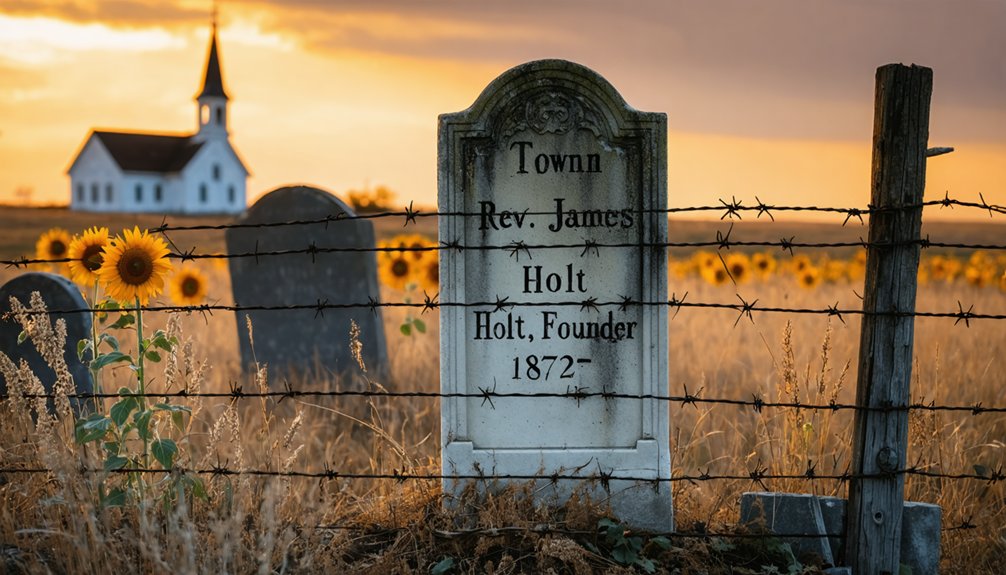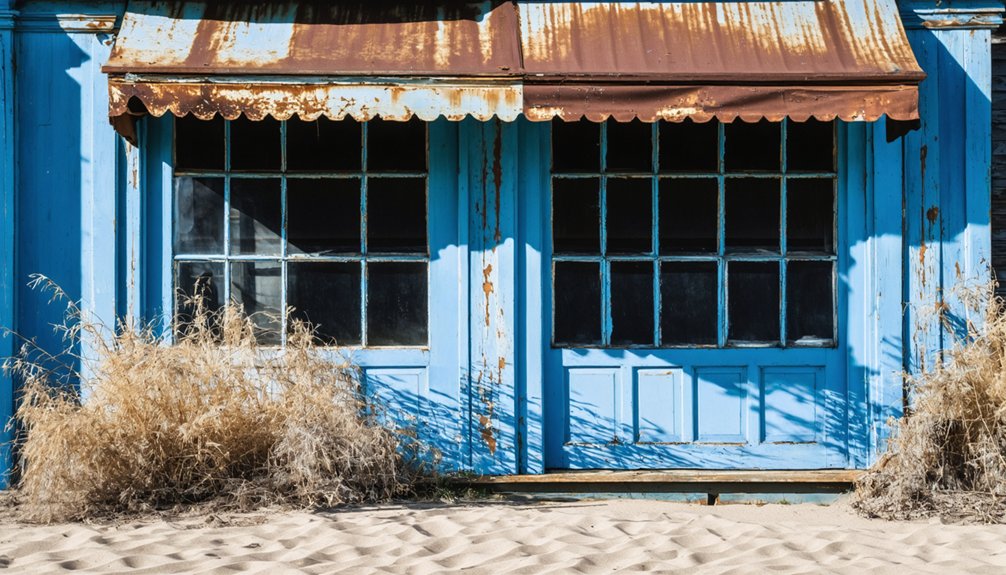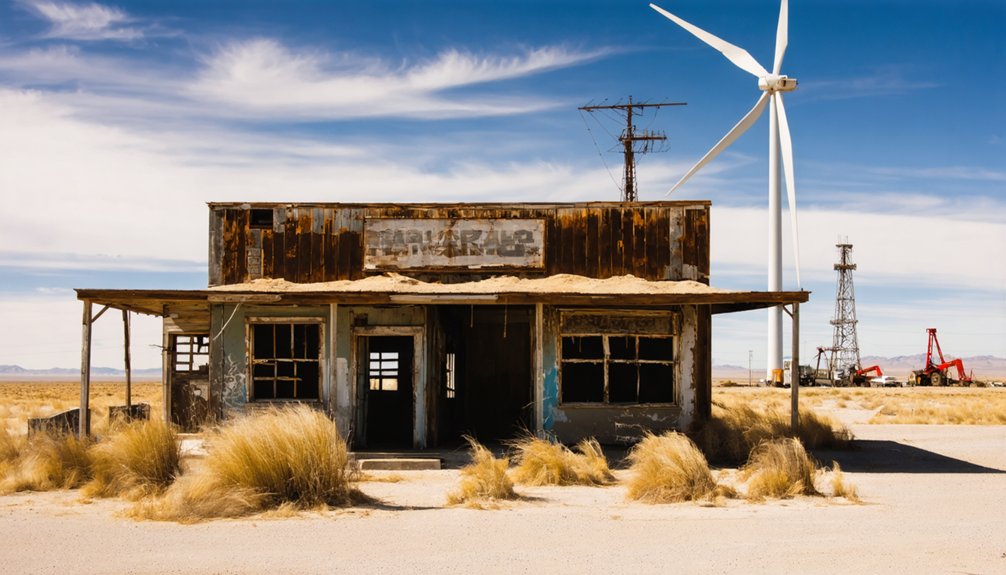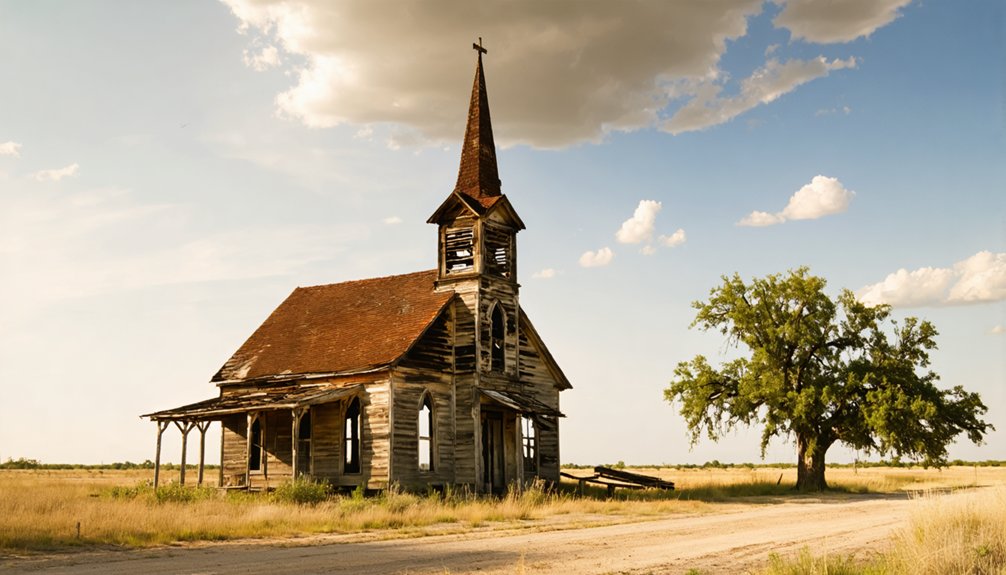You won’t find Sunnyside, Texas on any ghost town lists – it’s actually a thriving African-American community in southeast Houston. Founded in 1912 by former slaves seeking autonomy, Sunnyside has evolved from a suburban enclave into a significant cultural hub. Despite historical challenges of segregation and environmental justice issues, the area continues to grow with a $70 million solar farm project and mixed development initiatives. The neighborhood’s rich legacy of activism and leadership shapes its promising future.
Key Takeaways
- Sunnyside is not a ghost town but rather an active, historically Black community in Houston established in 1915.
- The community has faced challenges but maintains a population with ongoing development projects, including a $70 million solar farm.
- Early settlers built homes, businesses, and essential infrastructure like water districts and fire departments that continue operating today.
- Local institutions such as churches, schools, and civic organizations remain active in preserving community culture and driving progress.
- The area experiences economic struggles but sustains development through initiatives like TIRZ #26 and community-driven revitalization efforts.
Historical Roots and Community Foundation
Racial segregation in early 20th century Houston directly spawned the creation of Sunnyside, a pioneering African-American suburban enclave. You’ll find its origins rooted in the community’s response to overcrowding and blight in Houston’s Fourth, Fifth, and Sixth Wards, where discriminatory policies had confined Black residents.
As racial deed restrictions blocked African-Americans from purchasing homes elsewhere, Sunnyside emerged as a beacon of community resilience. Like the historically significant community of Sweet Home, it was established by former slaves seeking autonomy and opportunity.
Formally recognized by Houston in 1915, the neighborhood’s cultural heritage stems from its development as a self-contained community. You can trace how residents built their own businesses, schools, and homes, establishing economic independence despite systemic oppression. Today, Sandra Massy Hines continues to champion the community’s development as its honorary mayor.
Against all odds, Sunnyside’s residents forged their own thriving community, building the foundations of Black economic autonomy in segregated Houston.
The name “Sunnyside” itself reflects the hope this community represented – a brighter alternative to the harsh realities of Jim Crow segregation.
Early Settlement and Cultural Development
The 1912 platting of Sunnyside marked a bold step in Houston’s African-American history, as founder H.H. Holmes established this suburban haven for families seeking refuge from overcrowded inner-city conditions.
You’ll find that early settlers built their homes gradually, often one room at a time, creating a self-reliant community that preserved their cultural heritage despite segregation.
Between 1910 and 1945, you’d have witnessed the neighborhood’s transformation as residents established essential services like a water district and volunteer fire department.
While they couldn’t afford cars, they maintained proximity to employment centers. The community’s traditions flourished through local churches, schools, and social networks. The residents drew inspiration from stories and essays like those in A. A. Milne’s Sunnyside to educate their children and maintain their literary traditions.
Despite facing persistent racism and limited resources, Sunnyside’s residents created a vibrant, self-sufficient enclave that celebrated their independence and shared values.
Geographic Location and Environmental Impact
As you explore Sunnyside’s location within Harris County, you’ll find it positioned at coordinates 29.6641199, -95.3679941, strategically placed near major Houston highways SH 288 and IH 610.
Similar to Carroon Mortuary’s efforts to preserve local history through grave markers, the community has worked to document and protect its environmental heritage.
Like the disambiguation guide used to clarify multiple locations sharing the same name, clear documentation helps distinguish Sunnyside from other communities facing similar environmental challenges.
The community’s proximity to Sims Bayou has created ongoing environmental challenges, including flooding risks and concerns about water pollution that disproportionately affect local residents.
Your understanding of Sunnyside’s environmental justice issues must consider its historic exposure to soil contamination and urban pollution, factors that continue to shape the community’s relationship with its surroundings.
Environmental Justice Issues
Located in southeast Houston’s historically Black district, Sunnyside exemplifies decades of systemic environmental injustice through concentrated pollution sources and municipal waste sites.
Recent illegal dumping problems have continued to plague residents, highlighting ongoing environmental challenges. The city historically operated five landfills and incinerators in this area, demonstrating a pattern of discriminatory waste management practices. You’ll find a legacy of discriminatory land use, where landfills, incinerators, and industrial facilities were deliberately placed in this mainly Black neighborhood. The community has endured persistent exposure to toxic emissions, illegal dumping, and compromised infrastructure.
Despite these challenges, community resilience shines through the transformation of a 240-acre former landfill into America’s largest brownfield solar installation.
This $70 million project promises environmental restoration and economic opportunities, offering local jobs and reduced energy costs. It’s projected to power thousands of homes while eliminating hazardous conditions, marking an essential step toward addressing long-standing environmental inequities in Sunnyside.
Geographic Placement Near Houston
Situated approximately 8 miles south of Downtown Houston, Sunnyside occupies a strategic position between Loop 610 and Beltway 8, with State Highway 288 defining its western border.
This urban geography includes several distinct neighborhoods, with Sunnyside Place standing as the oldest African-American community in south central Houston, established in 1912.
Your understanding of Sunnyside’s environmental planning challenges stems from its proximity to Sims Bayou and historical land uses. The area’s past includes a landfill (now Sunnyside Park), a garbage incinerator, and numerous salvage yards.
These facilities, combined with the South Loop Industrial Park’s presence, have created ongoing environmental concerns. While the location offers convenient access to Houston’s major thoroughfares, you’ll find the community’s placement has historically exposed residents to environmental burdens and flooding risks. The neighborhood developed significantly during the 1940s and 1950s when water district formation provided essential services to over 2,000 homes. The HCA Houston Healthcare Medical Center lies over 6 miles north of the Medical Center Area.
Legacy of Activism and Civil Rights
Throughout its history, Sunnyside emerged as a powerful center of African American activism and civil rights advocacy in Houston, driven by residents who consistently fought against racial discrimination, involuntary displacement, and systemic neglect.
You’ll find that activism strategies in Sunnyside developed through organizations like the Texas Organizing Project, which champions four fundamental rights: choice, stability, equality, and participation in urban planning.
The community’s civil rights legacy is evident in its transformation of spaces like Sunnyside Park from a landfill to a crucial community resource.
Despite facing redlining, racially restrictive covenants, and municipal neglect, residents created autonomous spaces and secured essential services through grassroots organizing.
Today’s activists continue this tradition by confronting gentrification pressures, advocating for equitable public services, and ensuring community voices shape local development decisions. Civic leaders actively engage in monthly community meetings where residents can voice concerns and work directly with familiar neighborhood representatives.
Notable Figures and Community Leaders

Among Sunnyside’s prominent leaders, you’ll find John S. Chase, Texas’ first Black architect, and Zeb F. Poindexter, the pioneering first Black graduate of UT’s School of Dentistry.
You’ll recognize the lasting impact of Rodney Jones, Sr., whose civic club leadership established Sunnyside TIRZ 26 in 2015, marking a significant step in the area’s economic development.
The neighborhood’s educational advocates and civil rights activists have left an enduring legacy through institutions like the Sunnyside Colored School, which joined HISD in 1927 and became a cornerstone of community advancement.
Civil Rights Pioneers
Led by visionary community leaders, Sunnyside’s civil rights pioneers carved out a remarkable legacy of resistance and progress in southern Houston.
You’ll find their community resilience exemplified in pioneers like Zeb F. Poindexter, who broke barriers as the first African-American graduate from the University of Texas School. The Sunnyside Civic Club, established in 1936, became an essential force in fighting systemic discrimination and advocating for fundamental infrastructure.
In the face of redlining and Jim Crow laws, these civil rights leaders fostered economic independence through local businesses and fought for basic services.
Their activism continued through the 1940s and ’50s, securing significant improvements like the volunteer fire department and the Sunnyside Water District, which served over 2,000 homes by 1945.
Educational Leadership Legacy
Since the establishment of Sunnyside Colored School in 1918, Sunnyside’s educational leadership has shaped the community’s trajectory through generations of dedicated figures and activists.
You’ll find inspiring examples of educational resilience in leaders like Pat Thomas and T.C. Pickett, who emerged as pivotal voices in advancing local education.
The formation of the Sunnyside Civic Club in 1936 demonstrated the community’s commitment to empowerment through education.
Religious leaders like Bishop C.D. Boulden and Pastor Henry Price broadened their influence beyond church walls to advocate for educational advancement.
Sandra Massie-Hines and community historians such as Rodney L. Jones preserved Sunnyside’s legacy while pushing for continued progress.
Despite economic challenges in the 1970s and 1980s, these leaders maintained their focus on educational equity and community development.
Community Activism Icons
Throughout Sunnyside’s history, prominent community activists have shaped the neighborhood’s trajectory while fighting against racial segregation and social injustices.
You’ll find that grassroots leadership emerged through organizations like the Sunnyside Civic Club, established in 1936, which became a cornerstone of community empowerment. Notable figures like John S. Chase, Texas’s first Black architect, exemplified professional achievement despite systemic barriers.
The community’s activism legacy continues through organizations like the Holmes Community Development Corporation, founded in 1997.
These leaders have championed environmental justice, fought against harmful facilities in their neighborhood, and pushed for economic development through initiatives like TIRZ 26 and the Sunnyside Solar Farm project.
Their persistent advocacy has led to significant policy changes and improved living conditions for residents.
Architecture and Urban Evolution

As one of Houston’s oldest African-American communities, Sunnyside’s architectural legacy began in 1912 with H. H. Holmes establishing the foundation for its unique urban architecture.
You’ll find the community’s early design reflected both the constraints and resilience of its residents during the Jim Crow era, with modest one-story wood homes built by determined families.
– The 1915 Sunnyside Colored School and 1922 Mt. Vernon Baptist Church anchored early community design.
- Post-WWII expansion brought the Brookhaven neighborhood in 1943.
- “Black Wall Street” emerged in the 1970s as a vibrant commercial district.
- Infrastructure modernization in the 1940s-50s served over 2,000 homes.
- A 52-megawatt solar facility with 150MW battery storage capability
- Mixed-income housing developments targeting families at various income levels
- Agricultural training hub creating year-round economic opportunities
- Workforce development programs funded by a $750,000 Congressional allocation
- https://texashousers.org/wp-content/uploads/2017/02/sunnysideplan_forweb.pdf
- https://www.homes.com/local-guide/houston-tx/sunnyside-neighborhood/
- https://www.youtube.com/watch?v=tWaaOyAo52c
- https://en.wikipedia.org/wiki/List_of_ghost_towns_in_Texas
- https://www.tshaonline.org/handbook/entries/sunnyside-tx-castro-county
- https://phmuseum.com/projects/that-sunnyside-pride
- https://www.tshaonline.org/handbook/entries/sunny-side-tx-waller-county
- https://www.sunnysidetx.org/about/history
- https://www.click2houston.com/news/local/2024/04/04/our-town-sunnysides-history-and-residents-today-who-are-making-a-difference/
- https://texashousers.org/wp-content/uploads/2017/02/sunnyside-plan-history.pdf
Despite economic challenges, Sunnyside’s architectural character evolved through multiple phases of development, from its initial residential patterns to later industrial zones and the creation of the 285-acre Sunnyside Park from a former landfill.
Present-Day Challenges and Preservation
Modern-day Sunnyside faces a stark reality that contrasts sharply with its architectural heritage. Community neglect has led to widespread urban decay, with illegal dumping and abandoned vehicles creating hazardous conditions throughout the neighborhood.
You’ll find apartment complexes deemed uninhabitable, plagued by pest infestations and structural deterioration.
Despite persistent calls to city services, residents encounter delayed or nonexistent responses to their environmental complaints. The lack of proper waste management and infrastructure maintenance has created a cycle of decline that threatens both public health and historic preservation efforts.
While longtime residents continue fighting for neighborhood improvement through media outreach and civic engagement, the absence of formal preservation planning leaves Sunnyside’s cultural heritage at risk.
Without coordinated city-community initiatives, the area’s authentic history remains overshadowed by its current challenges.
Economic Development and Future Outlook

Despite its troubled past, Sunnyside stands poised for an ambitious economic revival centered around a groundbreaking $70 million solar farm project. This economic revitalization initiative will transform a 240-acre landfill into America’s largest urban solar installation, promising sustainable growth and community engagement through targeted development strategies.
Key components driving Sunnyside’s transformation include:
You’ll find TIRZ #26 funds being strategically reinvested to stimulate private capital while preserving local character.
The development plan emphasizes infrastructure improvements, job creation, and affordable housing, ensuring current residents benefit from the area’s economic renaissance.
Frequently Asked Questions
How Did Local Churches Influence Sunnyside’s Development During Segregation?
You’ll find church leadership actively resisted segregation policies by establishing community services, fostering Black entrepreneurship, organizing civil rights activism, and providing safe spaces for cultural preservation and social empowerment.
What Traditional Festivals or Celebrations Were Unique to Sunnyside Residents?
You’d have found Sunnyside’s cultural heritage alive at Sunnyside Park’s community gatherings, where civic club events, school graduations, and voter registration drives blended celebration with empowerment under segregation’s shadow.
How Did Public Transportation Access Shape Sunnyside’s Growth Over Time?
You’ll find that limited transportation routes initially isolated Sunnyside, restricting population shifts until the 1950s when highway development and annexation finally connected residents to Houston’s economic opportunities.
What Role Did Local Sports Teams Play in Sunnyside’s Community Life?
Like beating hearts of steel, local sports teams forged Sunnyside’s unwavering community identity. You’d witness how their triumphs galvanized residents, as team spirit transformed weekend games into powerful celebrations of cultural resilience.
How Did Sunnyside Residents Maintain Food Security During Economic Hardships?
You’d maintain food security through community gardens, backyard farming, and active barter systems. You’d share produce with neighbors, preserve harvests, and participate in cooperative buying groups to stretch limited resources.



